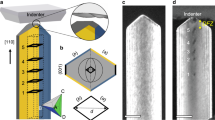Abstract
Crystalline pentagonal nano- and microrods (PRs) and pentagonal nano- and microparticles (PPs) with 5-fold symmetry are studied. Structure of PRs and PPs and their elastic distortions are characterized in the framework of the disclination approach. Relaxation of mechanical stresses due to disclinations causes structural transformations in PRs and PPs. Experimental evidence of such transformations, namely, the appearance of internal cavities and pores, and growth of whiskers in copper PRs and PPs grown in the process of electrodeposition is demonstrated. A brief review of existing models of stress relaxation in PRs and PPs is presented. We discuss a new model of nanowhisker growth based on the nucleation of two dislocation loops of opposite signs near the surface of the crystal with disclination. As a result, vacancy-type dislocation loop remains in the material and serves as a nucleus for cavity, while the interstitial loop comes to the free surface and contributes to whisker growth.






Similar content being viewed by others
References
S. Ino: Epitaxial growth of metals on rocksalt faces cleaved in vacuum. II. Orientation and structure of gold particles formed in ultrahigh vacuum J. Phys. Soc. Jpn. 21, 346 (1966).
H. Hofmeister: Forty years study of fivefold twinned structures in small particles and thin films Cryst. Res. Technol. 33, 3 (1998).
V.G. Gryaznov, J. Heydenreich, A.M. Kaprelov, S.A. Nepijko, A.E. Romanov, and J. Urban: Pentagonal symmetry and disclinations in small particles Cryst. Res. Technol. 34, 1091 (1999).
M.J. Yacaman, J.A. Ascencio, H.B. Liu, and J.-T. Gardeaorresday: Structure shape and stability of nanometric sized particles J. Vac. Sci. Technol, B 19, 1091 (2001).
K. Koga and K. Sugawara: Population statistics of gold nanoparticle morphologies: Direct determination by HREM observations Surf. Sci. 529, 23 (2003).
A.A. Vikarchuk and A.P. Volenko: Pentagonal copper crystals: Various growth shapes and specific features of their internal structure Phys. Solid State 47, 352 (2005).
I.S. Yasnikov: Elastic stress relaxation in pentagonal fine particles and crystallites of electrolytic origin Tech. Phys. Lett. 52, 666 (2007).
D. Seo, C.I. Yoo, I.S. Chung, S.M. Park, S. Ryu, and S. Hyunjoon: Shape adjustment between multiply twinned and single-crystalline polyhedral gold nanocrystals: Decahedra, icosahedra, and truncated tetrahedra J. Phys. Chem. C 112, 2469 (2008).
Z. Tang and N.A. Kotov: One-dimensional assemblies of nanoparticles: Preparation, properties, and promise Adv. Mater. 17, 951 (2005).
De R. Wit: Partial disclinations J. Phys. Chem. 5, 529 (1972).
A. Howie and L.D. Marks: Elastic strains and the energy balance for multiply twinned particles Philos. Mag. A 49, 95 (1984).
V.G. Gryaznov, A.M. Kaprelov, A.E. Romanov, and I.A. Polonsky: Channels of relaxation of elastic stresses in pentagonal nanoparticles Phys. Status Solidi B 167, 441 (1991).
L.D. Marks: Experimental studies of small particle structures Rep. Prog. Phys. 57, 603 (1994).
A.E. Romanov and V.I. Vladimirov: Disclinations in crystalline solids, in: Dislocations in Solids, edited by F.R.N. Nabarro Vol. 9 (North-Holland, Amsterdam, 1992) p.191.
A.E. Romanov and A.L. Kolesnikova: Application of disclination concept to solid structures Prog. Mater. Sci. 54, 740 (2009).
L.M. Dorogin, S. Vlassov, A.L. Kolesnikova, I. Kink, R. Lohmus, and A.E. Romanov: Crystal mismatched layers in pentagonal nanorods and nanoparticles Phys. Status Solidi B 247 (2), 288 (2010).
A.E. Romanov, I.A. Polonsky, V.G. Gryaznov, S.A. Nepijko, T. Junghanns, and N.I. Vitrykhovski: Voids and channels in pentagonal crystals J. Cryst. Growth 129, 691 (1993).
A.L. Kolesnikova and A.E. Romanov: Stress relaxation in pentagonal whiskers Tech. Phys. Lett. 33 (10), 886 (2007).
A.I. Mikhailin and A.E. Romanov: Amorphization of a disclination core Sov. Phys. Solid State 28, 337 (1986).
V.V. Rybin: Large Plastic Deformations and Fracture of Metals (Metalurgia, Moscow, 1986) [in Russian].
M.O. Peach: Mechanism of growth of whiskers on cadmium J. Appl. Phys. 23, 1401 (1952).
J.D. Eshelby: A tentative theory of metallic whisker growth Phys. Rev. 91, 755 (1953).
U. Lindborg: A model for the spontaneous growth of zinc, cadmium and tin whiskers Acta Metall. 24 (2), 181 (1976).
K.N. Tu and J.C.M. Li: Spontaneous whisker growth on lead-free solder finishes Mater. Sci. Eng, A 409, 131 (2005).
J.-H. Zhao, P. Su, M. Ding, S. Chopin, and P.S. Ho: Microstructure-based stress modeling of tin whisker growth IEEE Trans. Electron. Packag. Manuf. 29, 265 (2006).
J. Smetana: Theory of tin whisker growth: The end game IEEE Trans. Electron. Packag. Manuf. 30, 11 (2007).
A.L. Kolesnikova and A.E. Romanov: Circular Dislocation-Disclination loops and Their Application to Solution of the Boundary Value Problems in the Theory of Defects (USSR Academy of Sciences, Leningrad, 1986) [in Russian].
A.L. Kolesnikova and A.E. Romanov: Virtual circular dislocation-disclination loop technique in boundary value problems in the theory of defects J. Appl. Mech. 71, 409 (2004).
Acknowledgments
The support of EU HF PIIF-GA-2008–220419 from Marie Curie program is acknowledged. The work was also partly supported by Estonian Science Foundation Grant 8420 and Estonian Nanotechnology Competence Centre (EU29996).
Author information
Authors and Affiliations
Corresponding author
Rights and permissions
About this article
Cite this article
Romanov, A.E., Vikarchuk, A.A., Kolesnikova, A.L. et al. Structural transformations in nano- and microobjects triggered by disclinations. Journal of Materials Research 27, 545–551 (2012). https://doi.org/10.1557/jmr.2011.372
Received:
Accepted:
Published:
Issue Date:
DOI: https://doi.org/10.1557/jmr.2011.372




